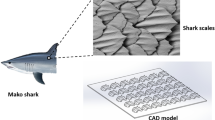Abstract
Under the inspiration of small riblets of shark skin, the microgroove drag reduction riblets whose direction set along fluid flow have been widely investigated. Herringbone-type riblets of bird flight feather are seldom exploited although bird also has excellent flight performance. Inspired from the flight feather, novel bio-inspired plane-3D (p-3D) and spatial-3D (s-3D) herringbone wall riblets are proposed. Through experiment measurement of drag reduction in water tunnel, maximum drag reduction of p-3D and s-3D herringbone riblets was about 17 and 20 %, higher than traditional microgroove riblets. Moreover, significant change of drag reduction was also found by change of the angle between herringbone riblets. In particular, maximum drag reduction occurred as angle between herringbone riblets was about 60° close to real flight feather, which indicates that microstructure of bird flight feather has great impact on flight performance.









Similar content being viewed by others
References
Ball P (1999) Engineering shark skin and other solutions. Nature 400:507–509
Bechert DW, Bruse M, Hage W, Van der Hoeven JGT, Hoppe G (1997) Experiments on drag-reducing surfaces and their optimization with an adjustable geometry. J Fluid Mech 338:59–87
Bechert DW, Bruse M, Hage W (2000) Experiments with three-dimensional riblets as an idealized model of shark skin. Exp Fluids 28:403–412
Chen HW et al (2013) Biomimetic drag reduction study on herringbone riblets of bird feather. J Bionic Eng 10(3):341–349
Choi H, Moin P, Kim J (1993) Direct numerical simulation of turbulent flow over riblets. J Fluid Mech 255:503–539
Coustols E (1989) Behavior of internal manipulators: “riblet” models in subsonic and transonic flows. AIAA paper 89-0963
Coustols E, Costeix J (1988) Turbulent boundary layer manipulation in zero pressure gradient. In: International conference on atomic spectroscopy, ICAS and AIAA. ICAS 88-3.7.3, pp 999–1013
Coustols E, Savill AM (1992) Turbulent skin friction drag reduction by active and passive means—1 and 2. In: Special course on skin friction drag reduction. AGARD R-786, GARD, Neuilly-sur-Seine, France, pp 8/1–8/80
Dean B, Bhushan B (2010) Shark-skin surfaces for fluid-drag reduction in turbulent flow: a review. Phil Trans R Soc A 368:4775–4806
Enyutin GV, Lashkov Y, Samoilova NV, Fadeev IV, Shumilkina EA (1991) Influence of downwash on the aerodynamic efficiency of fine-ribbed surfaces. Fluid Dyn 26:31–35
Hage W, Bechert DW, Bruse M (2000) Yaw angle effects on optimized riblets. Notes Numer Fluid Mech 76:278–285
Hirschel EH, Thiede P, Monnoyer F (1988) Turbulence management-applications aspects. In: Paper presented at the AGARD symposium on fluid dynamics of three-dimensional turbulent shear flows and transition, CP-438, Munich, FRG, 3–6 October 1988. AGARD, Neuilly-sur-Seine, France, pp 23/1–23/12
Klumpp S, Meinke M, Schröder W (2010) Numerical simulation of riblet controlled spatial transition in a zero-pressure-gradient boundary layer In Flow. Turbul Combust 85(1):57–71
Koeltzsch K, Dinkelacker A, Grundmann R (2002) Flow over convergent and divergent wall riblets. Exp Fluids 33:346–350
Nugroho B, Hutchins N, Monty JP (2013) Large-scale spanwise periodicity in a turbulent boundary layer induced by highly ordered and directional surface roughness. Int J Heat Fluid Flow 40:90–102
Oeffner J, Lauder GV (2012) The hydrodynamic function of shark skin and two biomimetic applications. J Exp Biol 215:785–795
Reif W-E, Dinkelacker A (1982) Hydrodynamics of the squamation in fast swimming sharks. Neue Jahrb Geol Paläontol Abhandl 164:109–120
Savill AM (1986) Effects on turbulent boundary layer structure of longitudinal riblets alone and in combination with outer layer devices. In: Veret C (ed) Flow visualization—IV. In: Proceedings of the fourth international symposium on flow visualization, 26–29 August 1986. Springer, Berlin, pp 303–308
Schneider M, Dinkelacker A (1993) Drag reduction by means of surface riblets on an inclined body of revolution. In: Speziale CG, Launder BE (eds) Near-wall turbulent flows. Elsevier, Amsterdam, pp 771–780
Tian L-m, Ren L-q, Liu Q-p, Han Z-w, Jiang X (2007) The mechanism of drag reduction around bodies of revolution using bionic non-smooth surfaces. J Bionics Eng 04(02):109–116
Walsh MJ (1983) Riblets as a viscous drag reduction technique. AIAA J 21(4):485–486
Walsh MJ, Lindemann AM (1984) Optimization and application of riblets for turbulent drag reduction. In: Presented at the AIAA 22nd aerospace sciences meeting, 9–12 anuary 1984, Reno, NV. AIAA paper 84-0347, pp 1–10
Walsh MJ, Weinstein LM (1978) Drag and heat transfer on surfaces with small longitudinal fins. AIAA paper 78-1161
Zhang DY, Luo YH, Chen HW, Jiang XG (2011a) Exploring drag-reducing grooved internal coating for gas pipelines. Pipeline Gas J 238(3):58–61
Zhang DY, Li YY, Han X, Li X, Chen HW (2011b) High-precision bio-replication of synthetic drag reduction shark skin. Chin Sci Bull 56:938–944
Acknowledgments
This work was supported by NSFC (51175020) and NSFC Major Program (51290292).
Author information
Authors and Affiliations
Corresponding author
Rights and permissions
About this article
Cite this article
Chen, H., Rao, F., Shang, X. et al. Flow over bio-inspired 3D herringbone wall riblets. Exp Fluids 55, 1698 (2014). https://doi.org/10.1007/s00348-014-1698-4
Received:
Revised:
Accepted:
Published:
DOI: https://doi.org/10.1007/s00348-014-1698-4




